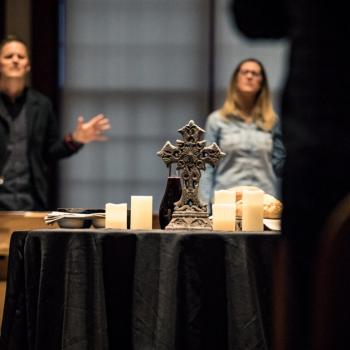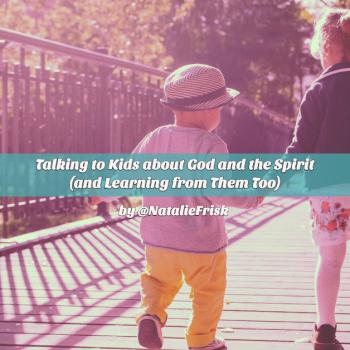
Provide a brief description of the congregation’s composition. Would you classify it as being homogeneous in any social, ethnic, economic, or age category? Or is the group heterogeneous? What seems to draw these people to this worshiping community?
This church is nearly homogenous in its ethnic category. Coptic Christians are uniquely connected to Egyptian culture. About 98 % of the people in the room were Egyptian, many of which used to live over there. Socioeconomically, they were all middle to middle-upper class in appearance. The church could also be described as a family environment. Every major age category had representation. I saw babies, kids, teens, young adults, young families, middle-agers, grandparents, and the elderly. They are nit together by their unique culture and unique approach to Christian faith and practice.
I sat in front of a couple who were inter-racial. I think this was the only couple there that was not both Egyptian. The wife was Mormon, but started going to Coptic youth functions as a teenager. After 4 years of questioning her upbringing and meeting with a priest, she was baptized into the church. She met her husband though this process. She saw that I “stood out” and helped me follow along. This was especially helpful because the worship service / liturgy switches between English, Coptic, and Arabic as the Priest feels appropriate. The liturgy book (we did the Liturgy of St. Basil) has three columns that parallel the three languages. This dynamic was awesome… but hard to keep up if you don’t know the flow. Her help made this experience so much better.
Finally, I mentioned that this was a family environment. I was intrigued by how the setting was both formal (stylistically) and informal (with family dynamics). They were ok with small kids wandering around and being silly, and okay with people interacting with each other throughout the service. This broke a major stereotype I had when I walked in.
Note the physical environment of worship. In what ways does the environment enhance/distract from worship? What environmental aids and symbols have been used? What do these aids and symbols communicate?
The environment was amazing. Orthodox to the max 🙂 What I mean by this is that the room contained icons everywhere. These were icons of saints, biblical characters, and Jesus. It was like I was stepping into the third century in many ways. I was also told, by a parishioner (who were all amazingly hospitable and almost made me want to convert… well, almost) that Coptic churches are built one of two ways. The first way, which is common to many “high church” communities, is the shape of a cross. This particular church, however was shaped like an Ark – reminiscent of Noah. What this communicates theologically is that the church is set apart from the destructive patterns of the world, and literally serves as a life-boat in the midst of brokenness. I thought this was profound.
I should add that women sit to the right and Men to the left when you walk in. This is more for tradition sake and not a “law.” Women all cover their head as a symbol of laying down their “crown” (which hair represents) before the King of Kings. I sat on the Men’s side toward the back. One married couple sits in the back together. The wife sits on the side closest to the women, but enjoy being together as a couple. This was not looked down upon. (this is the couple that helped me follow along)
Another interesting thing was that a wall separated the main congregational seating area from the altar. Much of the liturgy was read from the altar area, especially when incents were being offered to God during the first half of the service and when the Holy Eucharist was being prepared during the second half. The wall has three entrances: two on each side and one in the middle (the altar). The right side (if facing forward) is the side where the women would go to receive the element. The left side was for the men. When the entrances are not in use, a curtain covers them. Right now the curtains are white, symbolizing the joy of the resurrection (their Easter was last weekend, a week later than the West). The segmented part of the room where the altar sits represents the heavenly realm, and the rest of the church space represents the earthly realm. In Coptic / Orthodox theology, heaven and earth intersect, they are extremely and mysteriously close.
An interesting side note: I asked a couple of people about the issue of gender in worship. Both the young woman and my her husband told me that women and men are equally valued in the church. Women have some privileges that men do not have, such as bearing children. Men have some privileges that women do not have, such as the priesthood. Both are highly esteemed roles. In the case of the worship space and the “wall,” women are not allowed to enter the area where the altar is placed. This isn’t because they are viewed as “less than” but because of a purity issue. The reason is that women are ritualistically viewed as unclean because they have a menstrual cycle. When they receive communion, they do so outside of the Altar area. Interestingly, young girls are allowed near the altar (as they have not had a period yet) and technically, old women who are post-menopausal are also allowed back there. So much more I could say about gender mutuality but this gives an adequate picture.
Note the order of worship: Was there a theme? Did the order and flow of worship fit the theme? If so, how was the theme carried out? If there was no theme, what held the worship order together?
I couldn’t quite figure out if there was a “theme” per se. It was what they call St. Thomas Sunday, so the priest’s sermon focused on doubt. The first part of the worship service focused on the reading of Scriptures (which ended with the reading of the story of a saint). Then, they did a liturgy that led to an incense offering. It was hard to see what was going on exactly, but I am told that every visual and spoken action has a meaning, which everyone who is part of the church understands. These are not empty rituals for them like often assumed by outsiders! After this first half of the service, came the sermon (mentioned above). After about a 45 minute sermon (spoken in both Arabic and then translated into English in large segments by the priest), the service moved into a long liturgy that led to the Eucharist. This was seriously an amazing experience. I like the smells and bells of the Coptic church.
Note the level of participation in worship: Was the congregation predominantly active or passive? How were lay people involved in worship? What was the role of the worship leader or leaders?
This was highly participatory as most liturgical services are. They had spoken parts for “the people,” the priest, and for deacons (who ranged from under 12 to very old). Every spoken thing was sung to an ancient sounding Middle Eastern song. Even when the Bible was read aloud, it was sung!!!! I loved this. Also, during Communion the action of getting up and moving forward was full congregational action. Young and old went together with joy on their faces. This took about 20 minutes.
The Worship Leader, was the priest. He guided the service along. But, others were involved with helping aid in the singing of the liturgy. Father Yohanna came across as authoritative and yet loving and fun.
Note the components of worship, including praise, confession, intercession, offering, proclamation. How were the components of worship performed? What significant components of worship were missing?
I think all of these were present, as far as I could follow along. I might be tempted to say that “praise” wasn’t present based on my definitions, however that would be unfair to the context. They recited/sang the liturgy with much joy and in an attitude of praise to Jesus. They were not just cultural Christians but I got the sense that they truly love Christ.
Was technology employed in the service? If so, how? How effectively?
This is where I was shocked. They had two flat-screens up, in their ancient atmosphere, where the words of all three languages were projected for folks to follow along. They mirrored exactly what is in the prayer books. I’d say that it was effective.
Did you get the sense that this service connected with life beyond the worship space?
Very much so. I got the feeling that this worship service is one part of their weekly life as a community. There were LOTS of announcements about activities. Also, I was told that they were at church every day during their holy week. People plan to take vacation days during this week a year in advanced so that they can be part of the various Mass gatherings. They live and breath their common life together.
What revisions or additions in any of the above would you make in order to enhance the quality of worship?
I think that the Coptic Church has maintained its historical sytle while adapting various elements as fit. A good example of this is the willingness to use flat screens to aid in worship. I don’t think I would critique anything they did as it was a full expression of who they are as a people who worship God.
What new ideas did you gain that might assist you in your development of future worship services?
I was impressed with the hospitality of this congregation toward an “outsider” like me. They were all so excited to be Coptic Orthodox and invited me to come back any time. Their zeal for God and their tradition almost felt like “evangelization” but not in a coercive sense. By the time I left, I was given bread to take home, a phone number of a member to call if I had any questions, an invitation from the priest to call if I need anything, and was asked to come back again with my wife. How can I be part of cultivating an environment with members and clergy that clearly love God, their church, and tradition so much that it “leaks” out of them? That was a big take away.
I gained appreciation for the ancient church in a new way. The mystery of the liturgy, Eucharist, incense, and architecture woos me. Makes me yearn for the “ancient” paths of church while also locating myself as Anabaptist. I almost wish (sort of) that I could be both Orthodox and BIC 🙂











